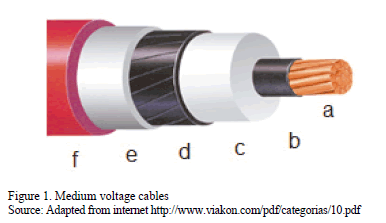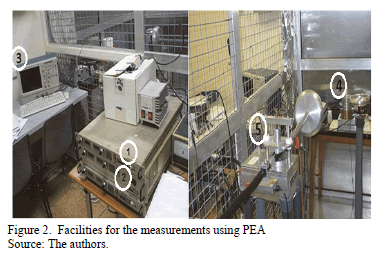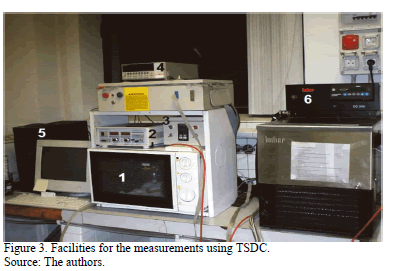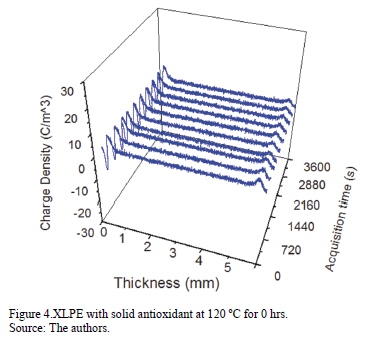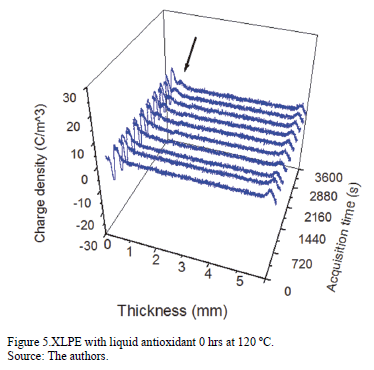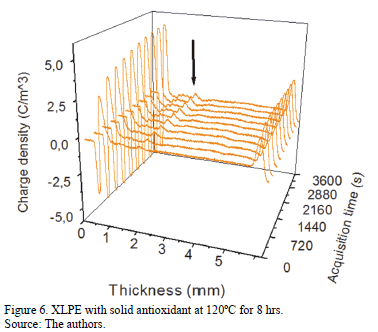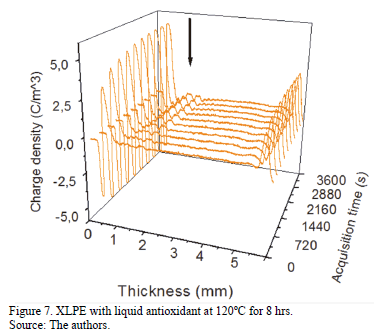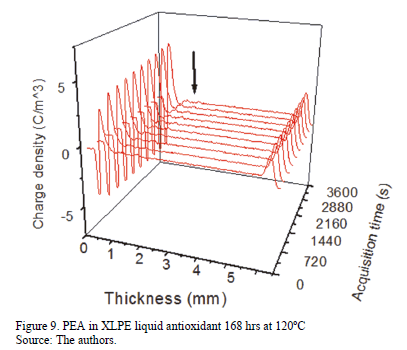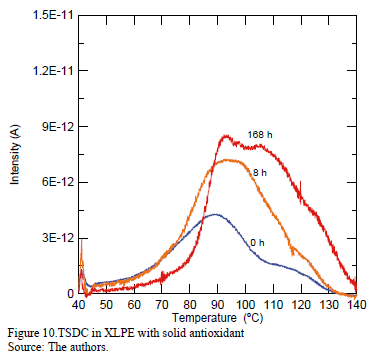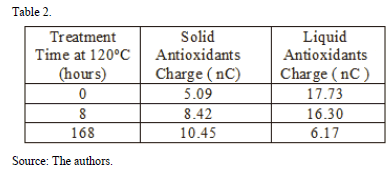Services on Demand
Journal
Article
Indicators
-
 Cited by SciELO
Cited by SciELO -
 Access statistics
Access statistics
Related links
-
 Cited by Google
Cited by Google -
 Similars in
SciELO
Similars in
SciELO -
 Similars in Google
Similars in Google
Share
DYNA
Print version ISSN 0012-7353
Dyna rev.fac.nac.minas vol.83 no.198 Medellín Sept. 2016
https://doi.org/10.15446/dyna.v83n198.50636
DOI: http://dx.doi.org/10.15446/dyna.v83n198.50636
Influence of solid and liquid antioxidants on the formation of space charge in the XLPE insulation of medium voltage cables
Influencia del antioxidante sólido y líquido sobre la formación de carga de espacio en el aislamiento de XLPE de cables de media tensión
Idalberto Tamayo-Ávila a, José Manuel Nieto-Jalil b, Jorge René Viteri-Moya c & Jenny Paulina Jácome-Jácome a
a Faculty of Engineering Sciences Industries, Equinoctial Technological University, Occidental Campus, Quito, Ecuador. idalberto.tamayo@ute.edu.ec
b Mechatronics Engineering Department, Monterrey Institute of Technology and Higher Education, Sonora Norte Campus, Mexico. jnietoj@itesm.mx
c Faculty of Chemical Engineering, Central University of Ecuador, Quito, Ecuador. jviteri@uce.edu.ec
Received: May 13th, 2015. Received in revised form: January 25th, 2016. Accepted: May 12th, 2016.
This work is licensed under a Creative Commons Attribution-NonCommercial-NoDerivatives 4.0 International License.

Abstract
In this work, the influence of antioxidants in solid and liquid states was studied on the formation of space charge when cross-linked polyethylene (XLPE) was insulated in medium voltage cables that were thermally treated for up to 168 hours at a temperature of 120 °C. The results, which used the pulsed electro-acoustic technique (PEA) with a voltage of 120 kV applied to the cable show the use of solid antioxidants in an increased formation of bulk charge in the XLPE in comparison to those who have used liquid antioxidant. The PEA measures are consistent with those obtained by the thermally stimulated depolarization currents (TSDC) technique, which also have a greater depolarizing current in samples that use a solid antioxidant.
Keywords: Space charge, cross-linked polyethylene, solid and liquid antioxidant, Pulsed Electro-acoustic (PEA), Thermally Stimulated Depolarization Currents (TSDC).
Resumen
En este trabajo se estudió la influencia del antioxidante en estados sólido y líquido en la formación de carga de espacio en el aislamiento de polietileno reticulado (XLPE) en cables de media tensión que fueron tratados térmicamente hasta 168 horas a la temperatura de 120 ºC. Los resultados mediante la técnica del Pulso Electroacústico (PEA) para una tensión de 120 KV aplicada al cable muestran que el uso de antioxidante sólido da como resultado una mayor formación de carga volumétrica en el XLPE comparado con los que se han usado antioxidante líquido. Las medidas PEA son coherentes con las obtenidas por la técnica de las Corrientes de Despolarización Estimuladas Térmicamente (TSDC) que también evidencian mayor corriente de despolarización en las muestras con antioxidante sólido.
Palabras clave: Carga de espacio, polietileno reticulado, antioxidantes sólido y líquido, Pulso Electroacústico (PEA), Corrientes de Despolarización Estimuladas Térmicamente (TSDC).
1. Introduction
The phenomenon of space charge is gaining more importance in the industry every day. It is also becoming more important for researchers as it helps them understand the space charge generating mechanisms or level of applied voltage, monitor the production process of insulating materials and study the possible deficiencies in the behavior of high voltage insulators. The term space charge describes the electrical condition of a poor conductor material that maintains electrical charges that are relatively immobile. The study of the effect of space charge on the properties of insulating materials is becoming more important due to its influence on the aging processes and dielectric rupture, which are limitations in their performance [1,2].
It is well known that having a space charge in insulating materials increases the electric field several times in relation to the applied field. This contributes to the increase in conductivity and triggers the dielectric rupture process that eventually decreases the cable performance and its service life.
A great deal of research work has addressed the causes of space charge formation in XLPE cable insulation. The phenomena in which space charge formation in materials have important effects include temperature [3,4], acetophenones [5], the by-products from the cross-linking reaction [6], antioxidants [7], as well as dielectric strengths, arborescences and aging. During extrusion of medium voltage cables, polyethylene insulation is subjected to stresses that cause cracks in the material [8] contributing formation and charge conduction.
Taking into account all of the above, it is important to know all the factors that contribute to space charge formation in order to reduce its presence in cable insulation and thus optimize it to extend its service life and improve its performance. Currently, dielectric materials doped with nanoparticles that reduce the formation of space charge are being researched [9,10].
2. Medium voltage cables
The medium voltage cables in this study (Fig. 1) are obtained through a process of vulcanization in which temperatures of up to 220ºC can be reached. It consists of a hard aluminum conductor (a), two semiconductor layers (b and d) that form interfaces with the XLPE insulation (c), a copper metallic shield (e) and a PVC sheath (f). In general, these cables are used in primary distribution networks. They work within a 10-20 kV voltage range and during their operation they can reach temperatures up to 90 ºC.
3. Pulsed electro-acoustic technique (PEA)
Space charge measurement is one of the most important variables to be studied in order to discover the factors that degrade insulation and also for the purpose of improving the quality of insulating materials. There are many techniques used to study space charge measurement that have emerged since the end of the last century and the beginning of this one. For this study, we are focusing on the Pulsed Electro-acoustic (PEA) technique. It consists of applying an electric pulse of a controlled frequency and amplitude to the dielectric material. The facilities used are shown in Fig. 2.
This technique consists of applying a controlled frequency electric pulse (pulse time = 40ns) and amplitude (400V) to the dielectric material using a pulse generator (1). The objective of this experiment is to find out the different samples of a disturbance.
The samples are placed between two electrodes in the cell that is to be measured (5) in a high voltage DC (2), at 120 kV. The consequence is that the internal electric field is modified which causes an electromagnetic interaction and creates an elastic wave. This is proportional to the charge that propagates to a piezoelectric transducer, transforming itself into a voltage signal. From the voltage signal profile load space with a deconvolution software is obtained.
The amplitude of the acoustic wave in the material is recorded in an oscilloscope (3) and this is related with the quantity and its distribution in the sample volume. The cable samples studied were conveniently prepared so that the pulsed electroacoustic (PEA) could be applied with high fields. The measurements were undertaken in the Dielectric Materials Physics Laboratory (DILAB) at Barcelona Tech.
4. Thermally Stimulated Depolarization Current Technique (TSDC)
This technique is based on the combined effect of electric field and temperature to polarize the material and freeze the polarization mechanisms while samples are being cooled (Fig. 3). Next, the material is depolarized by increasing the temperature, which leads to a depolarization electric current. Integrating the curve  gives a measure of the amount of charge in the volume of the material.
gives a measure of the amount of charge in the volume of the material.
The methodology used for the polarization and depolarization is described below:
- The sample is heated up to the temperature of polarization Tp (1)
- The polarizing field Ep is applied with high voltage DC (2) while the temperature remains constant.
- The sample is cooled at a constant velocity (Ve) until the temperature T0 (non-isothermal polarization) (6).
- The electric field is eliminated, which short-circuits the sample through an electrometer at temperature T0.
- The sample is heated, usually at a constant velocity (Vc), generating thermo-stimulated depolarization while the current detected by the electrometer (4) is recorded according to the temperature in the PC (5).
5. Results using the PEA technique
Figs. 4 and 5 show the PEA measurements on the cables that were not thermally treated. By undertaking a comparison, we are able to see that in the sample with liquid antioxidant a positive charge profile distribution can be observed that is close to the outer insulation surface (cathode). This is not observed in the cable with a solid antioxidant. If you refer to the charge density values in the Table 1 for 0 hours, it can be seen that the sample with liquid antioxidant charge density is higher in the cathode, the anode and the volume profile.
When the samples are treated for 8 hours at 120ºC, we can observe a similar charge distribution on both insulations near the cathode and anode (Figs. 6 and 7). However in the case of the solid antioxidant, two small charge distributions are formed close to the outer electrode. In the one with the liquid antioxidant, the initial distribution splits in two to produce a lesser value. The charge in the cathode is small for the sample with liquid antioxidants (values for 8 hours), as can be noted in Table 1.
Finally, when the samples are treated for 168 hours at 120ºC, it can clearly be observed in Figs. 8 and 9 that, in the XLPE solid antioxidant charge distributions are formed all the way to the center of the insulation. However, in the XLPE with liquid antioxidant, the charge in the volume distributions decreases and a better behavior in terms of space charge is achieved. Also, the charge on the inner cathode continues to decrease. This can be seen in Table 1 charge values for 168 hours
6. Results using the TSDC technique
When comparing the TSDC measurements, note the area under each curve in Figs. 10 and 11. It is clear that the sample with liquid antioxidant and no thermal treatment (0 h) has more accumulated charge than the sample with solid antioxidant. However, if the treatment time is increased at a temperature of 120 ºC on both samples, the results is different behavior. In the case of the sample with a solid antioxidant, the accumulated charge increases from 0 to 168 hours. However, in the one with the liquid antioxidant, the charge decreases.
In Table 2 we can observe the changes occurring in each case. These were calculated by obtaining the area under the curve in Figs. 10 and 11.
Although the liquid antioxidant initially generates more charge, after the thermal treatment it produces a better behavior since it tends to decrease the accumulated charge. This result may be caused by the fast decomposition of the liquid antioxidant, which produces more by-products that contribute to the formation of more charge. However, with the treatment they vaporize and are released from the XLPE, leaving a more homogeneous structure with less defects and less charge. We suggest either using the liquid antioxidant and increasing the crosslinking temperature during the process or having previous treatment to guarantee a thermal cleaning of the by-products for the crosslinking reaction. This will guarantee a lower amount of space charge in the volume of the XLPE and in the XLPE-semiconductor interface.
7. Conclusions
The use of a solid antioxidant in the XLPE insulation of the medium voltage cables studied contributes to the formation of a greater amount of space charge. This could be due to the fact that the solid antioxidant does not totally decompose in the cross-linking process, and the residues create defects in the inner structure. These act as a charge trapping and accumulation center.
The results obtained by using the TSDC technique are in line with those obtained from the PEA technique. Both cases show that the samples with solid antioxidants accumulate more space charge if they are heat treated for a longer time at 120 ºC.
To understand the complex form in which space charge in the cable insulation evolves, there is a need to carry out systematic studies that involve thermal and electric aging. It should be noted that space charge is a degrading factor for insulating materials that can foster other factors and that can also be unfavorable for insulation as it can cause partial discharges and dielectric ruptures. As we have demonstrated in this study performing a simple analysis on the samples with no aging can lead to contradictory interpretations.
References
[1] Chen, G., Space charge and its impact on DC breakdown of polymeric materials. 18th International Symposium on High Voltage Engineering. Seoul, KR, pp. 686-691, 2013. [ Links ]
[2] Sekii, Y., Suzuki, H., Noguchi, K. and Maeno, T., The negative heterocharge generation mechanism in polymeric dielectrics. IEEE Conf. Electr. Insul. Dielectr. Phenomena (CEIDP), pp. 404-408, 2007. [ Links ]
[3] Fu, F., Chen, G., Dissado, L. and Fothergill, J.C., Influence of thermal treatment and residues on space charge accumulation in XLPE for DC Power Cable Application, IEEE Trans. Dielectr. Electr. Insul., 14, pp. 53-64, 2007. DOI: 10.1109/TDEI.2007.302872 [ Links ]
[4] Tamayo, I., Belana, J., Cañadas, J.C., Mudarra, M., Diego, J.A. and Sellarès, J., Thermally stimulated depolarization currents of crosslinked polyethylene relaxations in the fusion range of temperatures. J. Polym Sci. Part B: Polym. Phys., 41, pp. 1412-1421, 2003. DOI: 10.1002/polb.10489 [ Links ]
[5] Doi, T., Tanaka, Y. and Takada, T., Measurement of space charge distribution in acetophenone coated low-density polyethylene. IEEE Annual Report of CEIDP, pp.32-35, 1997. DOI: 1109/CEIDP.1997.634552 [ Links ]
[6] Maeno, Y., Hirai, N., Ohki, Y., Tanaka, T., Okashita, M. and Maeno, T., Effect of cross-linking byproducts on space charge formation in cross-linked polyethylene. IEEE Trans. Dielectr. Electr. Insul., 12, pp. 90-97, 2005. [ Links ]
[7] Sekii, Y., Taya, A. and Maeno, T., Effect of antioxidants on space charge generation in cross-linked polyethylene and EPR. IEEE Conf. Electr. Insul. Dielectr. Phenomena (CEIDP), pp. 133-137, 2006. [ Links ]
[8] Lavoie, F.L., Bueno, B.deS. y Lodi, P.C., Evaluación de la fisuración bajo tensión de geo membranas pos ensayos acaelerados. DYNA, 81(183), pp. 215-220, 2014 [ Links ]
[9] Ohki, Y., Ishimoto, K., Kanegae, E., Tanaka, T., Sekiguchi, Y., Murata, Y. and Reddy, C.C., Suppression of packet-like space charge formation in LDPE by the addition of magnesia nanofillers. Properties and Applications of Dielectrics Materials. ICPADM 2009, pp. 9-14. 2009. DOI: 10.1109/ICPADM.2009.5252266 [ Links ]
[10] Wang, X., Zepeng, L., Kai, W., Chen, X., Demin, T. and Dissado, L.A., Study of the factors that suppress space charge accumulation in LDPE nanocomposites. IEEE Transactions on Dielectrics and Electrical Insulation 21(4), pp. 1670-1679. 2014. DOI: 10.1109/TDEI.2014.004292 [ Links ]
I. Tamayo-Ávila, gained a PhD in Applied Physics and Science Simulation from the Polythechnic University of Catalonia, Spain, in 2002. He has a BSc.degree in Physics and Astronomy from ISPH de Holguín, Cuba, in 1997. He worked as a professor of Physics at the Universidad de Holguín and as a researcher in Spectrum Analysis of Atomic Emission with Laser in Steel (1990-1998). He was an Associate Professor at the Polythechnic University of Catalonia (2005-2012) and a member of the DILAB group. He has worked on several research projects that have been published in scientific journals. He is currently a Professor in the Faculty of Engineering Sciences Industries Faculty at the Equinoctial Technological University in Quito, Ecuador. ORCID ID: 0000-0001-8752-8235
J.M. Nieto-Jalil, has a PhD in Physics from the University of Sonora, Mexico, in 2006. He is a full time Professor and Director of Mechatronics at the Monterrey Institute of Technology and higher Education, Sonora Norte Campus (since 2004). He has been a columnist in the Expreso Newspaper, and the State of Sonora since 2010 and also in the Ingenio Magazine. He is an evaluator in the National Register of Scientific and Technological Institutions and Enterprises of Mexico and a member of the FOMIX Evaluation Committee of Sonora as well as a technology Firms Consultant. He is also a researcher in Mechatronics and Nanotechnology areas. ORCID ID: 0000-0001-9908-2621
J.R. Viteri-Moya, has a PhD in Technical Sciences from the University of Matanzas, Cuba. He has been a Production Manager at EDESA-Quito and EDESA VENCERÁMICA-Venezuela, a Plant Manager at Foundation Mariana de Jesus, a director of the Editorial Team at the Enfoque UTE Magazine, a representative for CONESUP at the Environmental Observatory in Quito, a member of the Technical Advisory Board at the Ecuadorian Institute of Standardization-INEN, a member of the Ecuadorian Certification Committee S.G.S., and an external evaluator for CEAACES. He is currently a Professor in the engineering Sciences Faculty at the Central University of Ecuador. ORCID ID: 0000-0001-6444-301X
J.P. Jácome-Jácome, has a MSc. in Computer Engineering and Systems from the Autonomous University of the Andes and she has an undergraduate degree in Computer Science from Central University of Ecuador. She has a PGDip in Auditing Information Systems, a PGDip in Curriculum Design, a MSc. in Education Management, Sp. in Higher Education. She worked as an Instructor at the ICAM-Quito (Municipal Training Institute of Quito) and has also as a teacher at the Equinoctial Technological University in the Faculty of Engineering Sciences Industries since 2011. ORCID ID: 0000-0003-0314-7246













